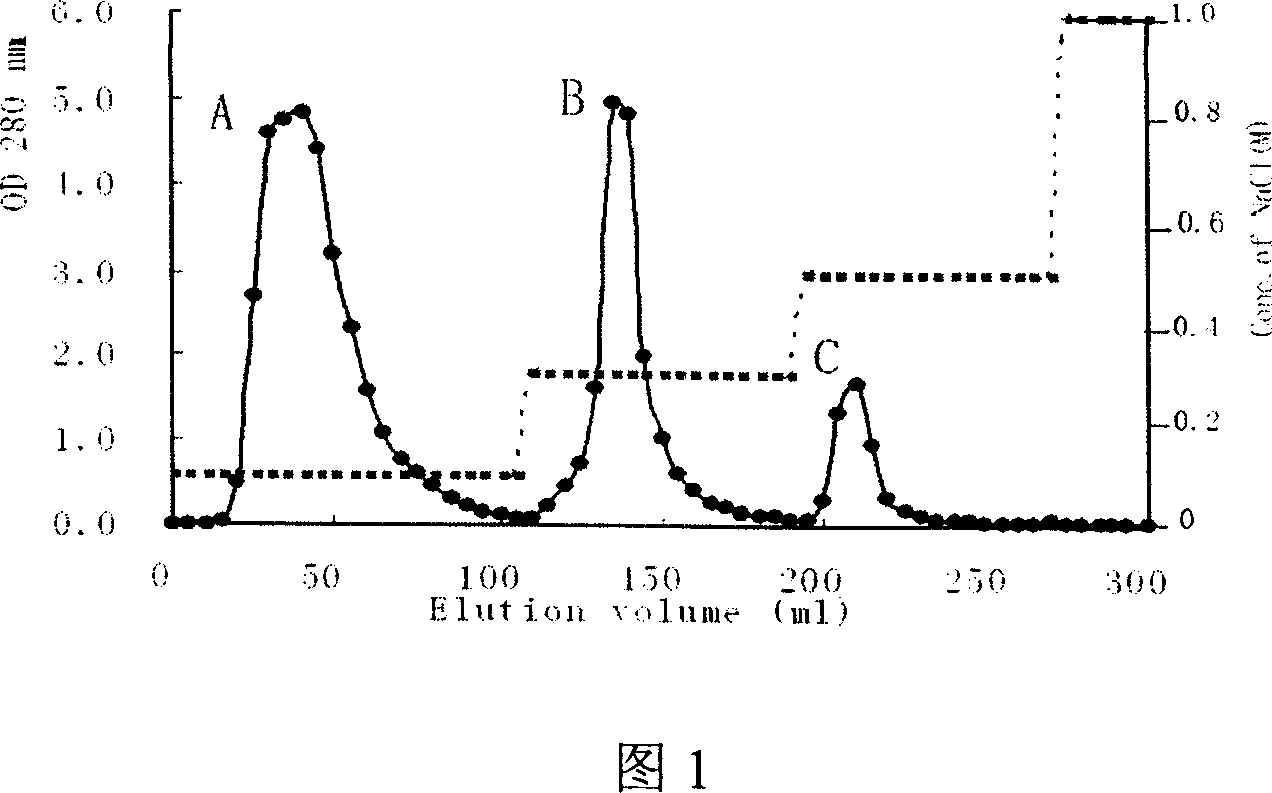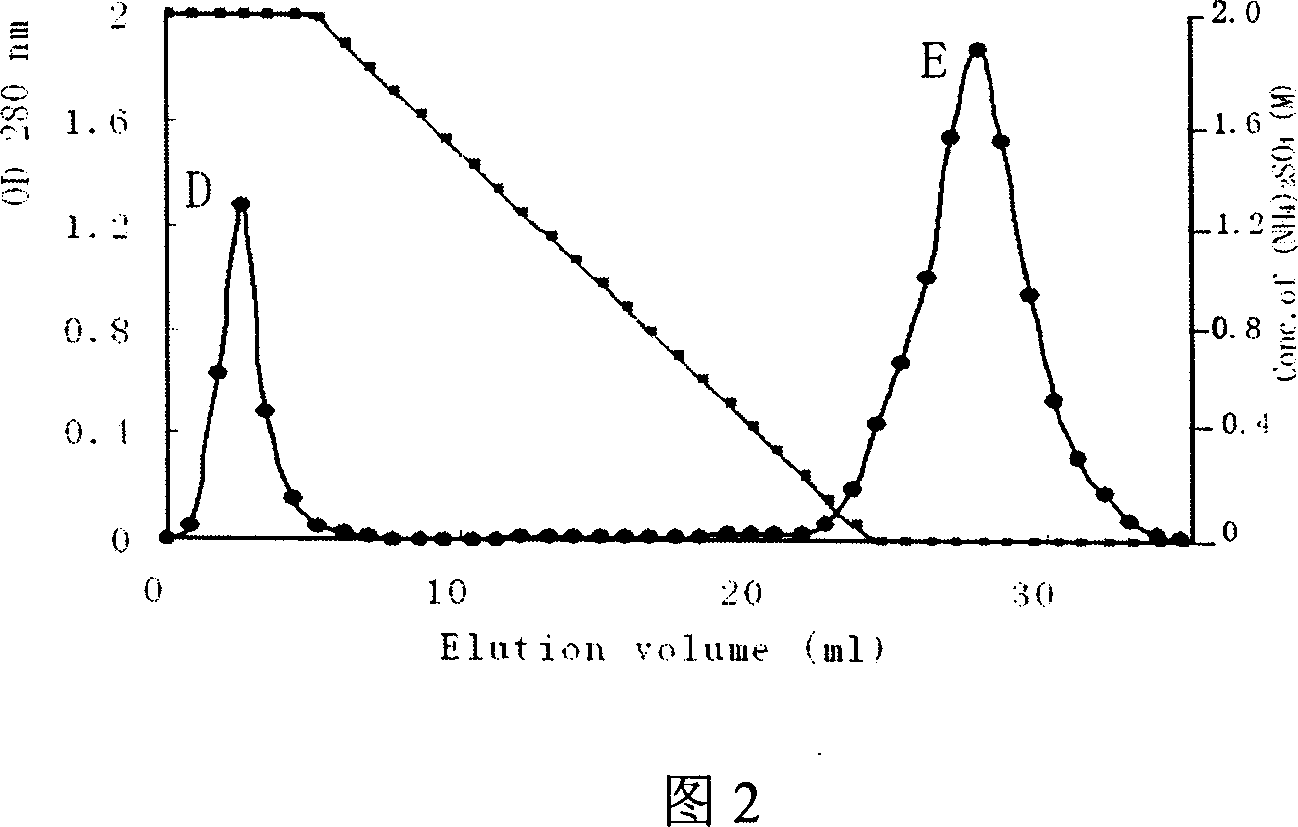Extracellular antiseptic protein for Bacillus subtilis and its separation and purification method
A Bacillus subtilis, protein technology, applied in the preparation methods of peptides, chemical instruments and methods, methods based on microorganisms, etc., can solve the problems that extracellular antibacterial proteins have not been deeply studied or seen, and can protect the natural quality of crops. , Wide application prospects, the effect of reducing pesticide residues
- Summary
- Abstract
- Description
- Claims
- Application Information
AI Technical Summary
Problems solved by technology
Method used
Image
Examples
Embodiment 1
[0037] Transfer Bacillus subtilis Bs-916 into YPG culture solution (the YPG culture solution is tryptone 5g, glucose 5g, yeast extract 5g), shake culture at 120r / min at 28°C for 48h, centrifuge at 10000rpm at 4°C for 10min, filter out The thalline is vacuum filtered with a bacterial filter to obtain the sterile filtrate of Bacillus subtilis Bs-916, and then ammonium sulfate is added to the sterile filtrate of Bacillus subtilis Bs-916, the saturation of ammonium sulfate is 100%, 4 After overnight at ℃, centrifuge at 12000rpm for 25min, remove the supernatant, wash the precipitate with 0.067mol / L phosphate buffer, put it in a dialysis bag (molecular weight cut-off is 8-10KD), dialyze at 4℃ for 48h, and obtain the Substance, that is, antibacterial crude protein.
[0038] The crude extracellular protein prepared above was passed through a DEAE Sepharose Fast Flow (manufactured by Amersh-am) chromatographic column with a column volume of 25 ml. DEAE Sepharose Fast Flow column chro...
Embodiment 2
[0041] The antibacterial protein bacteriostatic spectrum was determined by the filter paper method. The pathogens were Rhizoctonia solani, Magnaporthe grisease, Sclerotinia sclerotiorum, Alternaria oleracea, A. brassicae , Botrytis cinerea. Cultivate the above-mentioned pathogenic bacteria on PDA medium (200g of potatoes, 20g of glucose, 1000ml of water). In the center of the PDA medium plate, after mycelium grows, a sterile filter paper (65 mm in diameter) is placed diagonally at a distance of 25 mm from the mycelium, and isolated antibacterial protein is added to one side, and 0.067M phosphate buffer is added to the other side as control. Each treatment was repeated 3 times. When the hyphae grew to the control place, the antibacterial activity of the antibacterial protein against different pathogenic bacteria was observed. Antibacterial proteins were found against Basidiomycetes, such as rice sheath blight (see Figure 5), against Ascomycota, such as rice blast fungus (se...
Embodiment 3
[0047] Assay method for lectin activity: rabbit erythrocytes were obtained by centrifugation, and the rabbit erythrocytes were prepared into a 2% suspension with PBS buffer (pH 7.2). The antibacterial protein was double-diluted. At 20°C, take 50 μl of each concentration and 50 μl of 2% rabbit erythrocyte PBS suspension and mix them evenly in U-plates. At different concentrations, use protein-free phosphate buffer as a control. After standing at 20°C for about 1 hour, wait until the control erythrocytes are all precipitated, and observe the agglutination status of the erythrocytes in the treatment. The definition of the hemagglutination titer: The hemagglutination titer still exhibits lectin activity at the highest dilution factor. This concentration is one lectin unit (one titer) of the protein. The lectin activity of the protein is determined by how many per mg Expressed in units of lectin activity. The above method was used to determine, and the result showed that the prot...
PUM
 Login to View More
Login to View More Abstract
Description
Claims
Application Information
 Login to View More
Login to View More - R&D
- Intellectual Property
- Life Sciences
- Materials
- Tech Scout
- Unparalleled Data Quality
- Higher Quality Content
- 60% Fewer Hallucinations
Browse by: Latest US Patents, China's latest patents, Technical Efficacy Thesaurus, Application Domain, Technology Topic, Popular Technical Reports.
© 2025 PatSnap. All rights reserved.Legal|Privacy policy|Modern Slavery Act Transparency Statement|Sitemap|About US| Contact US: help@patsnap.com



